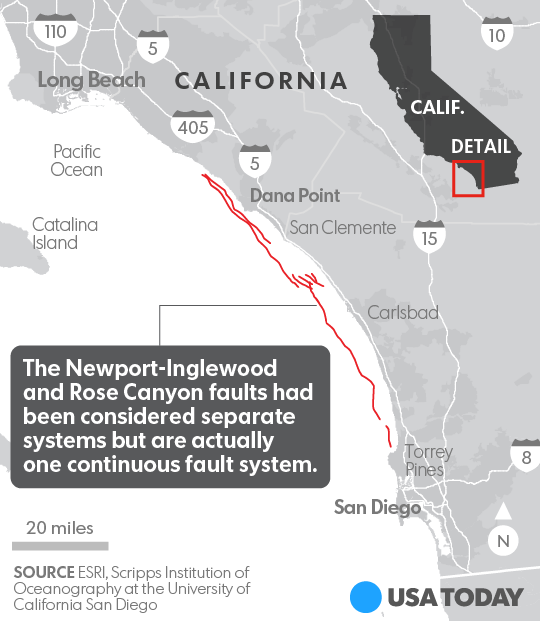A new report suggests Southern California could be overdue for a major earthquake. Sean Dowling (@seandowlingtv) has more.
Buzz60
Scientists uncovered a newly identified fault line that could unleash a magnitude-7.4 earthquake in the region, which other researchers say is already long overdue for a whopper of a temblor along the infamous San Andreas fault.
The concerns are detailed in separate studies that put the quake risks of the USA's most populous state into much sharper focus.
The newly identified fault line is capable of a powerful quake that would impact 20 million residents of Los Angeles and San Diego, according to a study published Tuesday. The fault runs underwater from San Diego Bay to Seal Beach in Orange County and on land through the Los Angeles basin, researchers found.
In the meantime, areas north of Los Angeles may be long overdue for a whopper of a quake along a portion of the San Andreas fault, according to a second study, this from the U.S. Geological Survey. Over the past 1,200 years, large earthquakes occurred there about every 100 years.
The last big one there was a magnitude-7.7 to 7.9 in 1857. At that time, the population of the entire state of California was less than 100,000 people. Today, it's 37 million. Most of the earliest quakes "appear to be quite large," between magnitude-7.0 and magnitude-7.5, said study lead author Kate Scharer of the USGS.
The land on each side of that portion of the San Andreas fault has been crushing together at a rate of over 1 inch per year since 1857, the researchers told the Los Angeles Times. This is causing accumulating energy that will be released in a major earthquake, when the land along the fault would move by many feet.
In the first study, the newly identified fault line is mostly offshore but never more than four miles from the San Diego, Orange County, and Los Angeles County coast, said study lead author Valerie Sahakian, formerly of the Scripps Institution of Oceanography and now with the U.S. Geological Survey.
Even a high magnitude-5 to a low magnitude-6 quake "can still have a major impact on those regions, which are some of the most densely populated in California,” she said.
The fault, officially known as the Newport-Inglewood/Rose Canyon fault zone, caused a 6.4-magnitude quake in Long Beach, Calif. that killed 115 people in 1933. About 3 million people lived in the entire Los Angeles metro area at that time. Today, that number is 13 million.
The Newport-Inglewood and Rose Canyon faults were considered separate system, but the study found they are actually one continuous fault system.
Both studies appeared in the American Geophysical Union’s Journal of Geophysical Research.
end quote from:
A new report suggests Southern California could be overdue for a major …

No comments:
Post a Comment